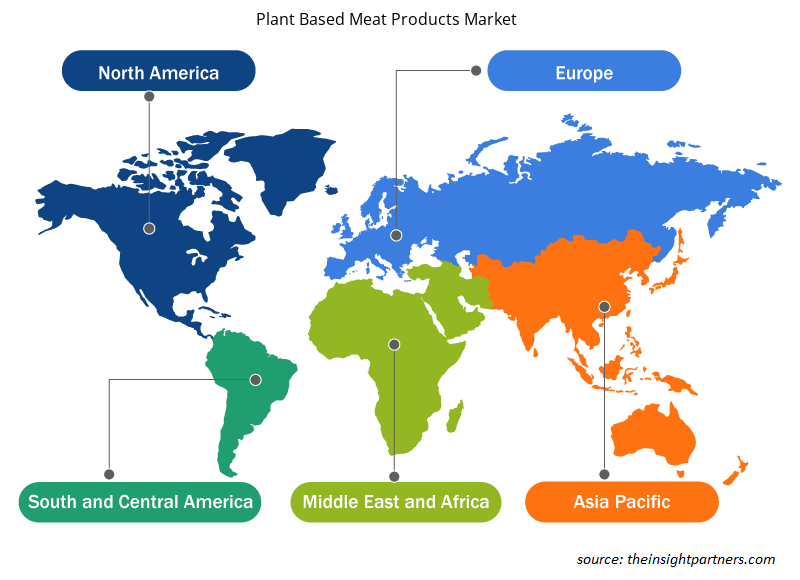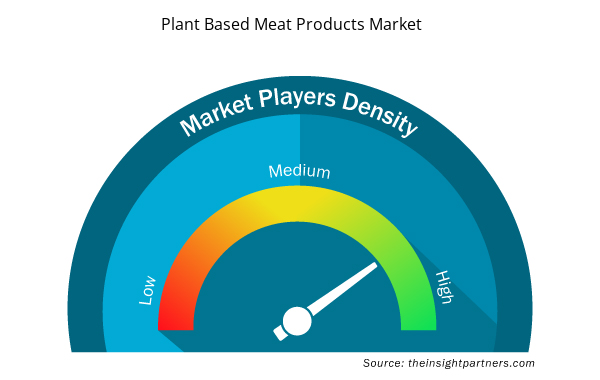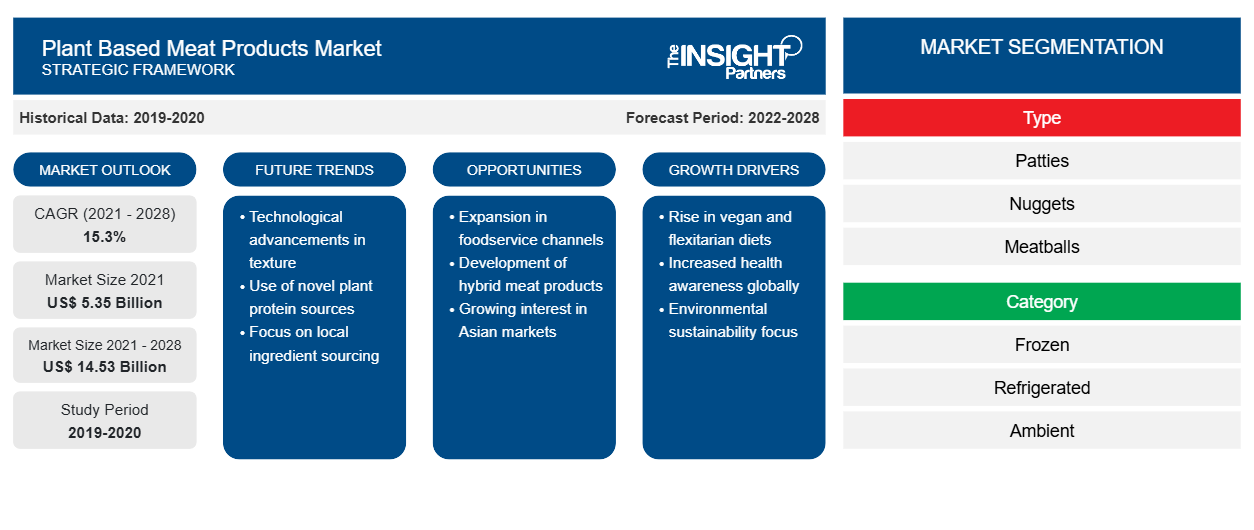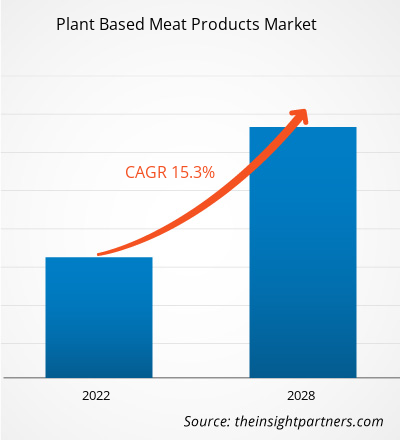[Rapporto di ricerca] Si prevede che il mercato dei prodotti a base di carne di origine vegetale raggiungerà 14.527,55 milioni di dollari entro il 2028, rispetto ai 5.354,72 milioni di dollari del 2021; si prevede che crescerà a un CAGR del 15,3% dal 2021 al 2028.
Approfondimenti di mercato e opinioni degli analisti:
I prodotti a base di carne di origine vegetale sono realizzati utilizzando proteine vegetali come proteine di soia, proteine di piselli e proteine di grano. Le proteine di soia sono ampiamente utilizzate per realizzare prodotti a base di carne di origine vegetale in quanto sono più convenienti di altre proteine vegetali e forniscono una consistenza ideale ai prodotti, simile ai prodotti a base di carne animale convenzionali. Polpette, bocconcini, salsicce e polpette sono alcuni dei prodotti a base di carne di origine vegetale più comuni disponibili sul mercato. I consumatori sono molto propensi a prodotti a base vegetale o vegani a causa delle crescenti preoccupazioni per la salute e della crescente consapevolezza riguardo al benessere degli animali. La crescente consapevolezza della salute tra le persone a causa della crescente prevalenza di obesità, diabete e altre malattie sta spingendo le persone a cambiare le proprie abitudini alimentari. Le persone generalmente percepiscono i prodotti a base vegetale come più sani dei prodotti convenzionali di origine animale. Questo fattore sta guidando in modo significativo la crescita del mercato dei prodotti a base di carne di origine vegetale
Fattori di crescita e sfide:
I prodotti a base di carne vegetale contengono meno grassi saturi e calorie rispetto ai prodotti a base di carne convenzionali, il che li rende una scelta più sana. Questo fattore sta guidando la crescita del mercato dei prodotti a base di carne vegetale. L'ascesa della tendenza al veganismo è anche attribuita alla crescente empatia verso gli animali. La crescente consapevolezza riguardo al maltrattamento degli animali nei macelli e nelle fabbriche ha sollevato preoccupazioni sulla protezione degli animali tra i consumatori. Si prevede inoltre che questo fattore incrementerà il consumo di alimenti a base vegetale, guidando il mercato dei prodotti a base di carne vegetale. Tuttavia, il suo prezzo elevato ne limita l'adozione tra i consumatori sensibili al prezzo. Nelle principali catene di supermercati, come Kroger e Walmart, due hamburger a base vegetale di Beyond Meat possono essere acquistati per circa 5,99 $ USA. D'altra parte, 2 libbre di carne macinata sono disponibili a circa lo stesso prezzo, il che potrebbe produrre 10 volte più hamburger. Pertanto, dopo aver confrontato i prezzi, i consumatori generalmente finiscono per acquistare carne convenzionale invece di carne a base vegetale, il che rappresenta un ostacolo alla crescita del mercato dei prodotti a base di carne vegetale . I produttori si stanno concentrando sul raggiungimento di economie di scala per ridurre il costo complessivo richiesto per la produzione di prodotti a base di carne vegetale. Tale iniziativa potrebbe aiutare i produttori ad acquisire nuovi clienti anche nei mercati sensibili al prezzo.
Personalizza questo report in base alle tue esigenze
Riceverai la personalizzazione gratuita di qualsiasi report, comprese parti di questo report, o analisi a livello nazionale, pacchetto dati Excel, oltre a usufruire di grandi offerte e sconti per start-up e università
- Scopri le principali tendenze di mercato in questo rapporto.Questo campione GRATUITO includerà analisi di dati che spaziano dalle tendenze di mercato alle stime e alle previsioni.
Segmentazione e ambito del report:
Il "mercato globale dei prodotti a base di carne a base vegetale" è segmentato in base a tipo, categoria, canale di distribuzione e area geografica. In base al tipo, il mercato dei prodotti a base di carne a base vegetale è segmentato in polpette, nugget, polpette, salsicce e altri. In base alla categoria, il mercato dei prodotti a base di carne a base vegetale è segmentato in surgelati, refrigerati e a temperatura ambiente. In base al canale di distribuzione, il mercato dei prodotti a base di carne a base vegetale è segmentato in supermercati e ipermercati, minimarket, vendita al dettaglio online e altri. Il mercato dei prodotti a base di carne a base vegetale in base all'area geografica è segmentato in Nord America (Stati Uniti, Canada e Messico), Europa (Germania, Francia, Italia, Regno Unito, Russia e resto d'Europa), Asia Pacifico (Australia, Cina, Giappone, India, Corea del Sud e resto dell'Asia Pacifico), Medio Oriente e Africa (Sudafrica, Arabia Saudita, Emirati Arabi Uniti e resto del Medio Oriente e Africa) e Sud e Centro America (Brasile, Argentina e resto del Sud e Centro America)UAE, and Rest of Middle East & Africa), and South & Central America (Brazil, Argentina, and Rest of South & Central America)
Analisi segmentale: Analysis:
In base al tipo, il mercato dei prodotti a base di carne vegetale è segmentato in polpette, nugget, polpette, salsicce e altri. Nel 2021, il segmento delle polpette deteneva la quota maggiore nel mercato dei prodotti a base di carne vegetale.
In base al canale di distribuzione, il mercato dei prodotti a base di carne vegetale è suddiviso in supermercati e ipermercati, minimarket, vendita al dettaglio online e altri. Il segmento supermercati e ipermercati ha detenuto la quota di mercato maggiore nel 2021 e si prevede che il segmento della vendita al dettaglio online registrerà il CAGR più elevato nel periodo di previsione. La vendita al dettaglio online è uno dei canali di distribuzione in più rapida crescita grazie alla sua praticità in termini di acquisto e consegna dei prodotti. I negozi al dettaglio online offrono un'ampia varietà di prodotti con forti sconti; inoltre, i consumatori possono acquistare comodamente prodotti desiderabili da remoto. Il servizio di consegna a domicilio attrae un vasto gruppo di clienti ad acquistare tramite una piattaforma di e-commerce. I siti Web di e-commerce offrono informazioni dettagliate sui prodotti, insieme alle recensioni degli utenti, che aiutano gli acquirenti a confrontare i prodotti e prendere decisioni informate. Questi fattori stanno guidando in modo significativo la crescita del segmento nei prossimi anni.CAGR over the forecast period. Online retail is one of the fastest-growing distribution channels owing to its convenience in terms of shopping and product delivery. Online retail stores offer a wide variety of products with heavy discounts; also, consumers can conveniently buy desirable products remotely. Home delivery service attracts a large group of customers to shop through an e-commerce platform. E-commerce websites offer detailed product information, along with user reviews, which help buyers compare products and make informed decisions. These factors are significantly driving the segment’s growth over the upcoming years.
Analisi regionale:
In base alla geografia, il mercato dei prodotti a base di carne di origine vegetale è suddiviso in cinque regioni chiave: Nord America, Europa, Asia Pacifico, Sud e Centro America e Medio Oriente e Africa. Le dimensioni del mercato globale dei prodotti a base di carne di origine vegetale per l'Europa hanno rappresentato 2.060,30 milioni di dollari nel 2021. Il Nord America è un secondo importante contributore che detiene una quota di oltre il 30% nel mercato globale. L'Asia Pacifico è anche uno dei mercati chiave per i prodotti a base di carne di origine vegetale che crescono a un CAGR di ~ 15%. I consumatori sono molto inclini verso i prodotti a base vegetale a causa della crescente consapevolezza riguardo al benessere degli animali. I benefici degli alimenti proteici senza colesterolo, con una consistenza simile alla carne, promuovono la crescita del mercato dei prodotti a base di carne di origine vegetale in Europa. Inoltre, con la crescente inclinazione dei consumatori verso i prodotti a base di carne di origine vegetale, i produttori stanno adottando strategie di crescita come lo sviluppo e l'espansione del prodotto per soddisfare le crescenti richieste dei consumatori. Ad esempio, Plant & Bean ha aperto una fabbrica di carne di origine vegetale a Boston e Lincolnshire (Regno Unito) nel dicembre 2020 per servire il mercato europeo. La capacità originaria di questa fabbrica era di produrre 55.000 tonnellate di carne di origine vegetale all'anno.
Sviluppi del settore e opportunità future:
Di seguito sono elencate le varie iniziative intraprese dai principali attori che operano nel mercato dei prodotti a base di carne di origine vegetale:
- Nel dicembre 2022, United Supermarket Holdings, Inc. ha lanciato "BEYOND BEEF", un'alternativa vegetale alla carne creata da Beyond Meat, Inc. BEYOND BEEF è un'alternativa vegetale alla carne macinata convenzionale, simile alla carne di manzo macinata, che può essere utilizzata come ingrediente in una varietà di piatti come hamburger, polpette e altri.
- Nell'ottobre 2022, Licious, un'azienda con sede in India, ha lanciato il marchio di carne a base vegetale "UnCrave", che comprende nel suo portafoglio kebab di carne di pollo e montone a base vegetale.
- Nel marzo 2022, Beyond Meat e PepsiCo hanno costituito una joint venture denominata "Planet Partnerships LLC" con il lancio della carne secca Beyond Meat realizzata con ingredienti 100% vegetali come piselli e fagioli mungo.
Approfondimenti regionali sul mercato dei prodotti a base di carne a base vegetale
Le tendenze regionali e i fattori che influenzano il mercato dei prodotti a base di carne a base vegetale durante il periodo di previsione sono stati ampiamente spiegati dagli analisti di Insight Partners. Questa sezione discute anche i segmenti e la geografia del mercato dei prodotti a base di carne a base vegetale in Nord America, Europa, Asia Pacifico, Medio Oriente e Africa e America meridionale e centrale.

- Ottieni i dati specifici regionali per il mercato dei prodotti a base di carne vegetale
Ambito del rapporto sul mercato dei prodotti a base di carne vegetale
| Attributo del report | Dettagli |
|---|---|
| Dimensioni del mercato nel 2021 | 5,35 miliardi di dollari USA |
| Dimensioni del mercato entro il 2028 | 14,53 miliardi di dollari USA |
| CAGR globale (2021 - 2028) | 15,3% |
| Dati storici | 2019-2020 |
| Periodo di previsione | 2022-2028 |
| Segmenti coperti | Per tipo
|
| Regioni e Paesi coperti | America del Nord
|
| Leader di mercato e profili aziendali chiave |
|
Densità dei player del mercato dei prodotti a base di carne vegetale: comprendere il suo impatto sulle dinamiche aziendali
Il mercato dei prodotti a base di carne a base vegetale sta crescendo rapidamente, spinto dalla crescente domanda degli utenti finali dovuta a fattori quali l'evoluzione delle preferenze dei consumatori, i progressi tecnologici e una maggiore consapevolezza dei benefici del prodotto. Con l'aumento della domanda, le aziende stanno ampliando le loro offerte, innovando per soddisfare le esigenze dei consumatori e capitalizzando sulle tendenze emergenti, il che alimenta ulteriormente la crescita del mercato.
La densità degli operatori di mercato si riferisce alla distribuzione di aziende o società che operano in un particolare mercato o settore. Indica quanti concorrenti (operatori di mercato) sono presenti in un dato spazio di mercato in relazione alle sue dimensioni o al valore di mercato totale.
Le principali aziende che operano nel mercato dei prodotti a base di carne di origine vegetale sono:
- Oltre la carne
- Marchio Conagra, Inc.
- Kellog
Disclaimer : le aziende elencate sopra non sono classificate secondo un ordine particolare.

- Ottieni una panoramica dei principali attori del mercato dei prodotti a base di carne a base vegetale
Impatto del Covid-19:
La pandemia di COVID-19 ha colpito quasi tutti i settori in vari paesi. I lockdown, le restrizioni di viaggio e le chiusure delle attività in Nord America, Europa, Asia Pacifico (APAC), Sud e Centro America (SAM) e Medio Oriente e Africa (MEA) hanno ostacolato la crescita di diversi settori, tra cui l'industria alimentare e delle bevande. Durante la fase iniziale della pandemia di COVID-19, gravi interruzioni della catena di fornitura hanno creato una carenza di materie prime, portando a un aumento dei prezzi delle materie prime. Secondo il Dipartimento dell'agricoltura degli Stati Uniti (USDA), i prezzi delle proteine dei piselli, uno degli ingredienti comuni utilizzati nella carne a base vegetale, sono aumentati a causa delle interruzioni nella catena di fornitura. Ciò ha comportato aumenti dei prezzi, con un impatto negativo sulla domanda di prodotti a base di carne a base vegetale. Tuttavia, a causa di un cambiamento significativo nelle preferenze alimentari dei consumatori, la domanda di prodotti a base di carne a base vegetale è aumentata drasticamente dopo lo scoppio del COVID-19. L'Organizzazione mondiale della sanità (OMS) ha pubblicato una linea guida sui prodotti alimentari che dovrebbero essere consumati durante la pandemia di COVID-19. La linea guida suggeriva di limitare il consumo di carne rossa a causa della sua alta percentuale di grassi saturi. Inoltre, le persone che si sono concentrate sulla riduzione del loro consumo complessivo di carne sono passate a diete vegetariane e vegane per migliorare l'immunità. Questi fattori hanno avuto un impatto positivo sulla crescita del mercato dei prodotti a base di carne di origine vegetale.
Scenario competitivo e aziende chiave:
Alcuni dei principali attori che operano nel mercato globale dei prodotti a base di carne vegetale includonoBeyond Meat; Conagra Brands, Inc.; Impossible Foods Inc.; Quorn Foods, Inc.; Kellogg Company; Hilary's Eat Well; Vbites Foods, Ltd.; Before the Butcher; Field Roast; e Tofurky; tra gli altri. Queste aziende sono fortemente coinvolte nell'innovazione di prodotto e nello sviluppo di nuovi prodotti per migliorare la loro competenza ed espandere il loro portafoglio prodotti. Inoltre, queste aziende stanno anche collaborando con altri attori del settore per soddisfare una base di clienti più ampia. Si prevede che tali iniziative forniranno un forte potenziale di crescita ai principali attori del settore che operano nel mercato dei prodotti a base di carne vegetale.
- Analisi storica (2 anni), anno base, previsione (7 anni) con CAGR
- Analisi PEST e SWOT
- Valore/volume delle dimensioni del mercato - Globale, regionale, nazionale
- Industria e panorama competitivo
- Set di dati Excel



Report Coverage
Revenue forecast, Company Analysis, Industry landscape, Growth factors, and Trends

Segment Covered
This text is related
to segments covered.

Regional Scope
North America, Europe, Asia Pacific, Middle East & Africa, South & Central America

Country Scope
This text is related
to country scope.
Domande frequenti
Europe accounted for the largest share of the global plant-based meat products market. Europe has emerged as a significant plant-based meat products market due to considerable demand for animal-meat alternatives from consumers owing to increasing health consciousness and the rising veganism trend.
The growing importance of environmental sustainability is expected to significantly drive the development of the plant-based meat products market over the forecast period. Also, the growth of the veganism trend is also attributed to growing affiliation with animals. Animals are ill-treated in slaughterhouses and factor which is raising concerns related to animal protection among consumers. This factor is also expected to boost the consumption of plant-based food. Thus, rising veganism and vegetarianism trends are projected to significantly drive the growth of the plant-based meat products market over the forecast period.
The major players operating in the global plant-based meat products market are Beyond Meat; Conagra Brands, Inc.; Kellogg’s Company; Tofurky; Field Roast; Before the Butcher; VBites Foods Inc.; Hilary’s – Drink Eat Well, LLC.; Quorn; and Impossible Foods Inc.
Plant-based meat is experiencing strong demand in emerging regions like the Asia Pacific and the Middle East & Africa. Rising demand for low or no meat diets owing to shifting consumer priorities towards sustainability and wellness is driving the plant-based meat industry across the Asia Pacific. On the other hand, plant-based meat is also gaining huge traction across the Middle East & Africa as consumers in the region are reducing their meat consumption in an attempt to lead a sustainable and healthy life. Thus, the surging demand for plant-based meat in emerging regions will provide a strong market potential over the forecast period.
The market scope for global plant-based meat products takes into consideration the retail sale of plant-based meat products and not the foodservice consumption.
Based on distribution channel, the supermarkets and hypermarkets segment accounted for the largest revenue share as the increasing urbanization, rising working-class population, and competitive pricing are boosting the popularity of supermarkets and hypermarkets in developed and developing regions. Moreover, manufacturers of plant-based meat products usually prefer to sell their products through supermarkets and hypermarkets owing to a heavy customer base.
Trends and growth analysis reports related to Food and Beverages : READ MORE..
The List of Companies - Plant-Based Meat Products Market
- Beyond Meat
- Conagra Brands, Inc.
- Kellogg’s Company
- Tofurky
- Field Roast
- Before the Butcher
- VBites Foods Inc.
- Hilary’s – Drink Eat Well, LLC.
- Quorn
- Impossible Foods Inc.
The Insight Partners performs research in 4 major stages: Data Collection & Secondary Research, Primary Research, Data Analysis and Data Triangulation & Final Review.
- Data Collection and Secondary Research:
As a market research and consulting firm operating from a decade, we have published and advised several client across the globe. First step for any study will start with an assessment of currently available data and insights from existing reports. Further, historical and current market information is collected from Investor Presentations, Annual Reports, SEC Filings, etc., and other information related to company’s performance and market positioning are gathered from Paid Databases (Factiva, Hoovers, and Reuters) and various other publications available in public domain.
Several associations trade associates, technical forums, institutes, societies and organization are accessed to gain technical as well as market related insights through their publications such as research papers, blogs and press releases related to the studies are referred to get cues about the market. Further, white papers, journals, magazines, and other news articles published in last 3 years are scrutinized and analyzed to understand the current market trends.
- Primary Research:
The primarily interview analysis comprise of data obtained from industry participants interview and answers to survey questions gathered by in-house primary team.
For primary research, interviews are conducted with industry experts/CEOs/Marketing Managers/VPs/Subject Matter Experts from both demand and supply side to get a 360-degree view of the market. The primary team conducts several interviews based on the complexity of the markets to understand the various market trends and dynamics which makes research more credible and precise.
A typical research interview fulfils the following functions:
- Provides first-hand information on the market size, market trends, growth trends, competitive landscape, and outlook
- Validates and strengthens in-house secondary research findings
- Develops the analysis team’s expertise and market understanding
Primary research involves email interactions and telephone interviews for each market, category, segment, and sub-segment across geographies. The participants who typically take part in such a process include, but are not limited to:
- Industry participants: VPs, business development managers, market intelligence managers and national sales managers
- Outside experts: Valuation experts, research analysts and key opinion leaders specializing in the electronics and semiconductor industry.
Below is the breakup of our primary respondents by company, designation, and region:

Once we receive the confirmation from primary research sources or primary respondents, we finalize the base year market estimation and forecast the data as per the macroeconomic and microeconomic factors assessed during data collection.
- Data Analysis:
Once data is validated through both secondary as well as primary respondents, we finalize the market estimations by hypothesis formulation and factor analysis at regional and country level.
- Macro-Economic Factor Analysis:
We analyse macroeconomic indicators such the gross domestic product (GDP), increase in the demand for goods and services across industries, technological advancement, regional economic growth, governmental policies, the influence of COVID-19, PEST analysis, and other aspects. This analysis aids in setting benchmarks for various nations/regions and approximating market splits. Additionally, the general trend of the aforementioned components aid in determining the market's development possibilities.
- Country Level Data:
Various factors that are especially aligned to the country are taken into account to determine the market size for a certain area and country, including the presence of vendors, such as headquarters and offices, the country's GDP, demand patterns, and industry growth. To comprehend the market dynamics for the nation, a number of growth variables, inhibitors, application areas, and current market trends are researched. The aforementioned elements aid in determining the country's overall market's growth potential.
- Company Profile:
The “Table of Contents” is formulated by listing and analyzing more than 25 - 30 companies operating in the market ecosystem across geographies. However, we profile only 10 companies as a standard practice in our syndicate reports. These 10 companies comprise leading, emerging, and regional players. Nonetheless, our analysis is not restricted to the 10 listed companies, we also analyze other companies present in the market to develop a holistic view and understand the prevailing trends. The “Company Profiles” section in the report covers key facts, business description, products & services, financial information, SWOT analysis, and key developments. The financial information presented is extracted from the annual reports and official documents of the publicly listed companies. Upon collecting the information for the sections of respective companies, we verify them via various primary sources and then compile the data in respective company profiles. The company level information helps us in deriving the base number as well as in forecasting the market size.
- Developing Base Number:
Aggregation of sales statistics (2020-2022) and macro-economic factor, and other secondary and primary research insights are utilized to arrive at base number and related market shares for 2022. The data gaps are identified in this step and relevant market data is analyzed, collected from paid primary interviews or databases. On finalizing the base year market size, forecasts are developed on the basis of macro-economic, industry and market growth factors and company level analysis.
- Data Triangulation and Final Review:
The market findings and base year market size calculations are validated from supply as well as demand side. Demand side validations are based on macro-economic factor analysis and benchmarks for respective regions and countries. In case of supply side validations, revenues of major companies are estimated (in case not available) based on industry benchmark, approximate number of employees, product portfolio, and primary interviews revenues are gathered. Further revenue from target product/service segment is assessed to avoid overshooting of market statistics. In case of heavy deviations between supply and demand side values, all thes steps are repeated to achieve synchronization.
We follow an iterative model, wherein we share our research findings with Subject Matter Experts (SME’s) and Key Opinion Leaders (KOLs) until consensus view of the market is not formulated – this model negates any drastic deviation in the opinions of experts. Only validated and universally acceptable research findings are quoted in our reports.
We have important check points that we use to validate our research findings – which we call – data triangulation, where we validate the information, we generate from secondary sources with primary interviews and then we re-validate with our internal data bases and Subject matter experts. This comprehensive model enables us to deliver high quality, reliable data in shortest possible time.


 Ottieni un campione gratuito per questo repot
Ottieni un campione gratuito per questo repot